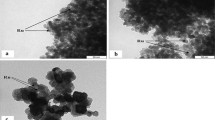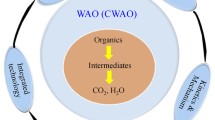The effect of reaction temperature, reaction time, initial chemical oxygen demand (COD), excess O2 (EO), and catalyst concentration on the efficiency of catalytic wet air oxidation (CWAO) treatment of refinery wastewaters consisting of various oily wastes, water, heavy metals, toxic compounds, etc. was studied. In general, COD decreases substantially with temperature, EO, and oxidation time. Addition of homogeneous Co2+-based catalysts reduces COD by as much as 98.7%.
Similar content being viewed by others
Explore related subjects
Discover the latest articles, news and stories from top researchers in related subjects.Avoid common mistakes on your manuscript.
The main sources of oily wastewater include oil refineries, petrochemical plants, metallurgical industries, and accidental oil spills to the water surface. Before being discharged into natural water bodies, oily wastewater must be treated [1]. Purified water must comply with the wastewater discharge standards (federal or local). According to the standards of China, oil content in the discharged purified wastewater cannot exceed 10 mg/L [2]. Hydrocarbons, even in small concentrations, are toxic to the microorganisms used for biological purification of wastewater.
One of the most efficient technologies for the treatment of high-concentration highly toxic and hazardous organic compounds into CO2, H2O, and other innocuous end products is wet air oxidation (WAO) at high temperatures and pressures using oxygen as the oxidant. This prevents the formation of NO x , SO2, HCl, dioxins, furans, and fly ash, etc. [3]. WAO is associated with high investment costs, since operation under high pressure requires equipment made of reinforced materials – special alloys resistant to corrosion, which is characteristic under WAO conditions. Research for the creation of catalysts that reduce the pressure and temperature necessary for the process has been conducted [4]. Catalytic WAO is performed under milder conditions, is characterized by faster reaction rates, and thus shortens process duration [5]. For these reasons, the development of WAO catalysts has been the subject of many studies in the past three decades [6–13].
The present study reports on the effects of temperature, initial chemical oxygen demand (COD), excess O2 (EO), reaction time, and the presence of a catalyst (Co2+) on the effectiveness of reducing COD of oil-contaminated wastewater.
WAO of oil-contaminated wastewater was performed in a 0.6 L batch autoclave. A schematic of the laboratory setup is shown in Fig. 1. Water and oil-contaminated effluents were loaded into the autoclave, and the system was purged with nitrogen gas to displace oxygen. A weighed out amount of catalyst (Co2+) was added to the autoclave. The reactor was filled with pure oxygen to a certain pressure. The temperature was raised to a predetermined value, and the reaction timer was set to start. Liquid samples (15 ml) were removed from the reactor periodically for analysis.
The COD of the collected samples was determined by the potassium dichromate method according to the Chinese Standard 11914-89. Excess oxygen EO was calculated using the equation
where (O2)in is the amount of O2 supplied to the reactor, mg/L; (O2) st is the stoichiometric amount of O2 required for complete oxidation of the feed (oil-contaminated wastewater) and equal to the initial COD of the oil-contaminated wastewater, mg/L.
Non-catalytic WAO
Fig. 2 displays the effect of temperature and reaction time on COD removal (excess oxygen equals 0.8). In all the experiments, COD removal increases rapidly during the first hour, after which the curves reach a plateau. In the course of the oxidation reaction, the concentration of organic substances in the water decreases leading to a decrease in the rate of oxidation.
Fig. 2 shows that an increase in temperature promotes further COD removal. At a temperature of 350 °C COD removal reaches 79.05% after 1 h and 88.37% within 4 hours from the start of the oxidation process. It is evident that the higher the temperature the greater the rate of oxidation reactions.
Effects of the initial COD of oil-contaminated wastewater and the oxidation reaction time on COD removal are demonstrated in Fig. 3 (temperature of 350 °C). As can be seen, with the increase of the initial COD from 10 to 40 g/L COD removal increases smoothly.
The results of studies of the effect of EO and Reaction time on the efficiency of COD reduction are shown in Fig. 4 (temperature of 350 °C). As can be seen, with increasing EO levels COD removal increases, reaching 88.37% for EO value of 0.8.
Catalytic WAO
Fig. 5 presents a comparison of the results of WAO in the presence of Co2+ catalyst at a concentration of 250 mg/L, and in its absence. The maximum COD removal under CWAO is 98.7%, and in the non-catalytic process it is only 77.35%. Cobalt ions effectively promote the oxidation of organic compounds found in oil-contaminated wastewater. The catalyst increases the rate of formation of hydroxyl radicals and their interaction with the intermediate compounds that form during the oxidation of oil-contaminated wastewater components.
Thus, the process of catalytic wet air oxidation is a more promising and effective oil-contaminated wastewater treatment technology in comparison with the non-catalytic process.
References
M. Fingas and B. Fieldhouse, Mar. Pollut. Bull., 47, 369-396 (2003).
L. L. Chi, R. T. Hai, X. H. Wang, and Y. Li, Technology of Water Treatment, 39, 87-89 (2013).
G. L. Jing, M. M. Luan, T. T. Chen, and H. Y. Wang, International Journal of Green Energy, 10, 378-386 (2013).
H. T. Gomesa, J. L. Figueiredo, J. L. Faria, P. Serp, and P. Kalck, J. Mol. Catal. A: Chem., V. 182–183, p. 47-60 (2002).
J. Levec and A. Pintar, Catal. Today., 124, 172-184 (2007).
A. B. Ayusheev, O. P. Taran, I. A. Seryak, O. Y. Podyacheva, C. Descorme, M. Besson, L. S. Kibis, A. I. Boronin, A. I. Romanenko, Z. R. Ismagilov, and V. Parmon, Applied Catalysis B: Environmental, 146, 177-185 (2014).
A. Vallet, G. Ovejero, A. Rodríguez, J. A. Peres, and J. García, J. Hazard. Mater., 244–245, 46-53 (2013).
E. Castillejos-Lopez, A. Maroto-Valiente, D. M. Nevskaia, V. Munoz, I. Rodriguez-Ramos, and A. Guerrero-Ruiz, Catal. Today., 143, 355-363, (2009).
H. Z. Wei, X. M. Yan, X. R. Li, S. B. He, and C. L. Sun, J. Hazard. Mater., V. 244–245, p. 478-488 (2013).
J. Gaalova, J. Barbier, and S. J. Rossignol, J. Hazard. Mater., 181, 633-639 (2010).
R. P. Rocha, A. M. T. Silva, S. M. M. Romero, M. F. R. Pereira, and J. L. Figueiredo, Applied Catalysis B: Environmental, 147, 314-321 (2014).
S. Collado, A. Laca, and M. Díaz, J. Hazard. Mater., 177, 183-189 (2010).
Y. Li, F. F. Zhang, X. M. Liang, and A. Yediler, Chemosphere, 90, 284-291 (2013).
This work was supported by the National Natural Science Foundation of China (11102233), a project of the General Staff Department of Military Training of People’s Liberation Army “Investigation of integrated technology for the protection of water drainage systems,” and the National High Technology Research and Development Program of China (2012AA062601-1).
Author information
Authors and Affiliations
Corresponding author
Additional information
Translated from Khimiya i Tekhnologiya Topliv i Masel, No. 1, pp. 51– 53, January– February, 2016.
Rights and permissions
About this article
Cite this article
Du, K., He, M., Lian, M. et al. Catalytic Wet Air Oxidation Treatment of Oily Wastewaters. Chem Technol Fuels Oils 52, 85–89 (2016). https://doi.org/10.1007/s10553-016-0676-3
Published:
Issue Date:
DOI: https://doi.org/10.1007/s10553-016-0676-3









